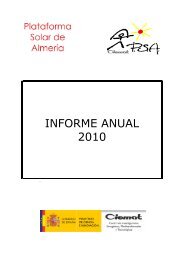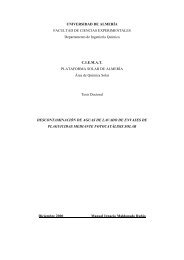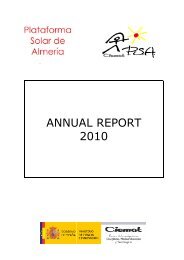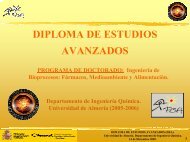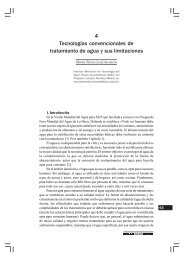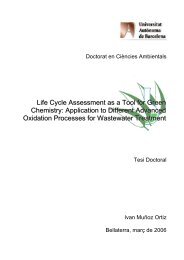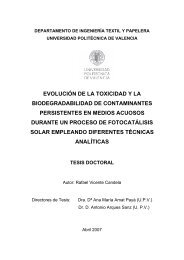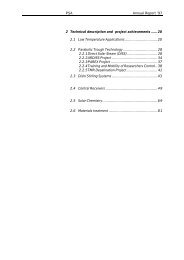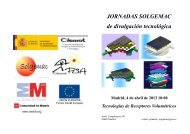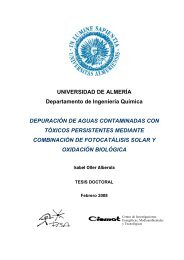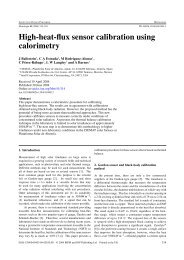Annual Report 2006 - Plataforma Solar de AlmerÃa
Annual Report 2006 - Plataforma Solar de AlmerÃa
Annual Report 2006 - Plataforma Solar de AlmerÃa
You also want an ePaper? Increase the reach of your titles
YUMPU automatically turns print PDFs into web optimized ePapers that Google loves.
CONCENTRATING SOLAR SYSTEMS UNIT<br />
technological and economic feasibility and their ability to reduce CO 2 emissions<br />
from more conventional hydrogen production systems, such as gasification<br />
and steam reforming.<br />
Purpose: The basic purpose of the project is to study clean hydrogen production<br />
processes in or<strong>de</strong>r to advance in the solution of its current technological<br />
and economic limitations key to being able to carry out a future transition<br />
to the hydrogen economy. The alternatives inclu<strong>de</strong>d in this project are characterized<br />
by avoiding formation of CO 2 as a coproduct of hydrogen and using<br />
renewable resources to provi<strong>de</strong> the energy consumed in the formation and<br />
release of hydrogen.<br />
1. Hydrogen production from water by photo<strong>de</strong>composition<br />
2. Hydrogen production from water by solar thermochemical cycles<br />
3. Hydrogen production from natural gas by catalytic <strong>de</strong>carbonization<br />
4. Comparative analysis of the above possibilities<br />
Results achieved in <strong>2006</strong>: Although CIEMAT participates in several of the subprojects,<br />
its main <strong>de</strong>dication is to Subproject 2, related to thermochemical<br />
hydrogen production. CIEMAT activity in PHISICO2 is largely complemented<br />
by activities and <strong>de</strong>velopments in the Solter-H project. In <strong>2006</strong>, the scientific<br />
effort concentrated on the synthesis, physical-chemical characterization and<br />
thermogravimetric testing of mixed transition-metal oxi<strong>de</strong>s to i<strong>de</strong>ntify their<br />
efficiency in hydrogen production, especially at optimum process temperatures<br />
in or<strong>de</strong>r to select the most suitable for solarization. Work was also done<br />
on assembly of a laboratory test bench. Synthesis, physical-chemical characterization<br />
and thermal reduction of Mn x Ni 1-x Fe 2 O 4-δ in a thermobalance, were<br />
also done by varying Ni/Mn between 0 and 3. Wet synthesis Ni, Fe and Mn<br />
nitrates was performed by the Pechini method from. In all cases, thermogravimetric<br />
tests were ma<strong>de</strong> with different heating ramps using nitrogen, helium<br />
or air as the carrier gas. Air would be best from the point of view of industrial<br />
scale-up, since it would avoid the use of an inert gas with the resulting cost<br />
Figure 3.25 Activation stage weight loss testing done in<br />
the thermogravimetric balance, with<br />
weightloss over temperature for mixed<br />
ferrite Ni x Mn 1-x Fe 2 O 4 samples (with nitrogen<br />
carrier and heat ramp of 20ºC/min)<br />
61



